We all use personal computers and we all take them for granted in our everyday lives. It’s easy to forget that PCs have only been around for a couple of decades, and initially were nowhere near the powerhouses we have on our desks today.
For example, did you know that the first “portable” computer weighed 25 kg (55 lb) and cost close to $20,000, that the first laser printer was big enough to fill up most of a room, or that you basically had to build the first Apple computer yourself?
This article takes a look at the time when the computer equipment we now take for granted was invented and what it looked like back then.
The first computer mouse
The first computer mouse was invented in 1963 by Douglas Engelbart at the Stanford Research Institute. (He is also one of the inventors of hypertext.) The first mouse used two wheels positioned at a 90-degree angle to each other to keep track of the movement (see picture below). The ball mouse wasn’t invented until 1972, and the optical mouse was invented circa 1980 although it didn’t come to popular use until much later.
Douglas Engelbart never received any royalties for his invention and his patent had run out by the time the mouse became commonplace in the era of home PCs.
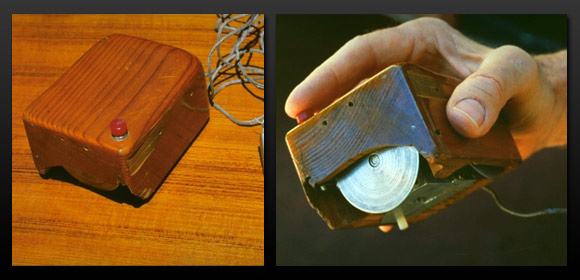
Above: The first mouse. To the right you can see the wheels it used for movement and positioning.
The first trackball
The trackball was actually invented 11 years BEFORE the mouse, in 1952. It was invented by Tom Cranston and Fred Longstaff as part of a computerized battlefield information system called DATAR, initiated by the Canadian Navy. It used a standard five-pin bowling ball as its trackball, which is smaller than the more common 10-pin bowling ball.
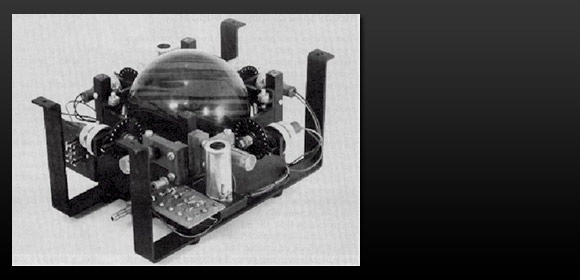
Above: The first trackball, bowling ball and all.
The first portable computer
Well, perhaps that should be “movable” computer… The IBM 5100 Portable Computer was introduced in 1975, weighed 25 kg (55 lb), was the size of a small suitcase and needed external power to operate. It held everything in the same unit, packing in a processor, ROM (several hundreds of KB) and RAM (16-64 KB), a five-inch CRT display, keyboard and a tape drive, which was an amazing feat at the time. It also came with built-in BASIC and/or APL. The different models of the IBM 5100 sold for $8,975 – $19,975.
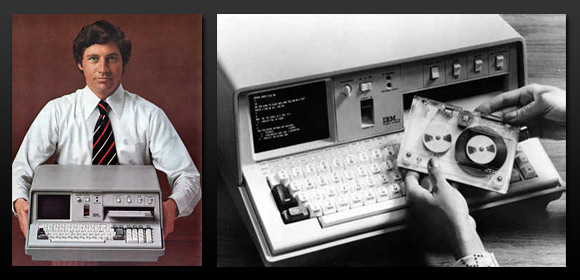
Above: The IBM 5100 Portable Computer.
The first laptop computer
The first laptop computer (or notebook) was the Grid Compass 1100 (called the GRiD) and was designed in 1979 by a British industrial designer, Bill Moggridge. The computer didn’t start selling until 1982, then featuring a 320×200 screen, an Intel 8086 processor, 340 KB of magnetic bubble memory (a now obsolete, non-volatile memory type) and a 1200 bps modem. It weighed 5 kg (11 lb) and cost $8-10,000. The GRiD was mainly used by NASA and the US military.
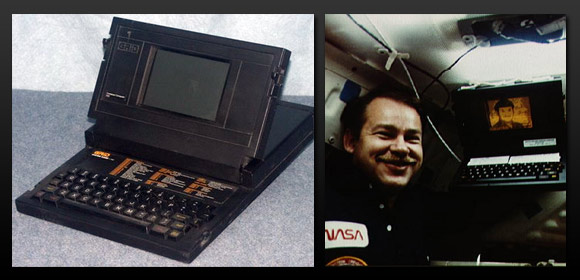
Above left: Closeup of the Grid Compass 1100. Above right: NASA astronaut posing with the GRiD in space (that’s Spock on the screen.)
The first IBM PC
The IBM Personal Computer was introduced in 1981 as the IBM 5150. The platform became so pervasive in the 80s that although the term “personal computer” had been in use since the early 70s, a PC became synonymous with an IBM PC-compatible computer.
During its development, the IBM 5150 had been internally referred to as “Project Chess” and was created by a team of 12 people headed by Don Estridge and Larry Potter. To speed up development and cut costs, IBM had decided to use off-the-shelf parts, something that they normally wouldn’t do.
The first IBM PC had an Intel 8088 processor, 64 KB of RAM (extendible to 256 KB), a floppy disk drive (which could be used to boot the computer with a rebranded version of MS-DOS (PC-DOS)) and a CGA or monochrome video card. The machine also had a version of Microsoft BASIC in ROM. On the first IBM PC the optional 10 MB hard disk drive could only be installed if the original power supply was replaced (the original one was too weak).
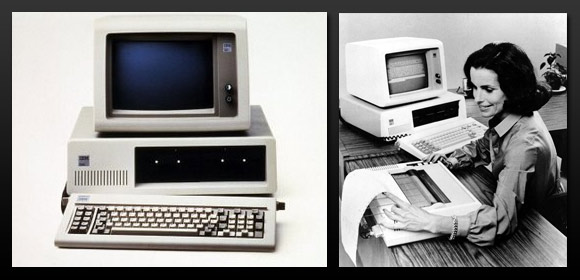
Above: The first IBM Personal Computer, the IBM 5150.
The first Apple computer
The first Apple personal computers (Apple I) were designed and hand-built by Steve Wozniak. The Apple I went on sale in 1976 for the price of $666.66. Only about 200 units were produced. The Apple I was basically just a motherboard with a processor, a total of 8KB of RAM, a display interface and some additional functionality. To have a working computer, the buyer would have to add a power supply, a keyboard and a display (and a case to keep mount it all in).
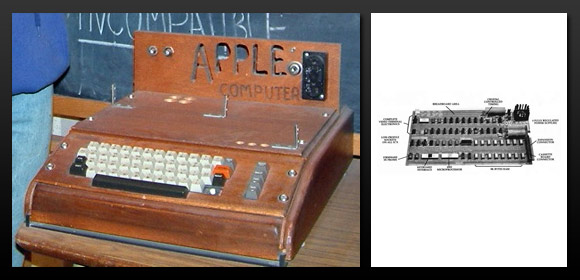
Above left: An Apple I computer. Above right: This was the Apple I, essentially a motherboard.
The first RAM
Arguably the first (writable) random access memory was Magnetic Core Memory (also called Ferrite-Core Memory) and was invented in 1951 as a result of work done by An Wang at Harvard University’s Computation Lab and Jay Forrester at MIT.
Core memory was a family of related technologies that used the magnetic properties of materials to give them a similar functionality to transistors. They stored their information using the polarity of tiny, magnetic ceramic rings with wires threaded through them. Unlike today’s RAM, core memory could keep its information even after the power was turned off.
Core memory was common until it was replaced by integrated silicon RAM chips in the 1970s. The “core” in core memory is why a memory dump is called a “core dump” even today.
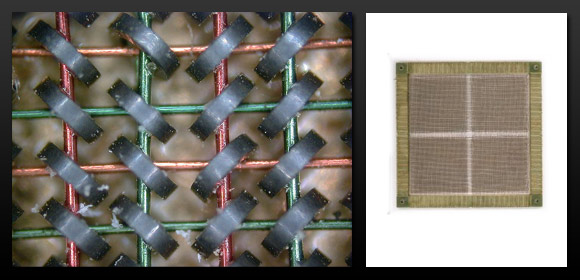
Above left: Closeup of core memory. Above right: The core memory plane in the picture is 16×16 cm (6.3×6.3 inches), holding 128×128 bits (2048 byte).
The first hard disk drive
The IBM Model 350 Disk File was the first hard disk drive and was part of the IBM 305 RAMAC computer that IBM started delivering in 1956 (mainly intended for business accounting). It had 50 24-inch discs that together could store about 4.4 MB of data. The Model 350 spun at 1200 rpm, had a data transfer rate of 8,800 characters per second and an access time of approximately one second.
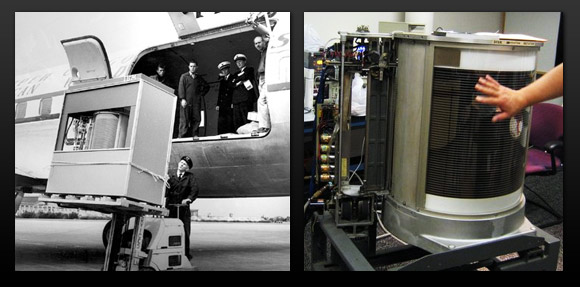
Above: The first hard disk drive, IBM Model 350.
The first laser printer
The laser printer was invented by Gary Starkweather at XEROX in 1969. His initial prototype was a modified laser copier where he had disabled the imaging system and introduced a spinning drum with eight mirrored sides. The first commercial implementation of a laser printer didn’t happen until IBM released the IBM model 3800 in 1976. It could pretty much fill up a room on its own.
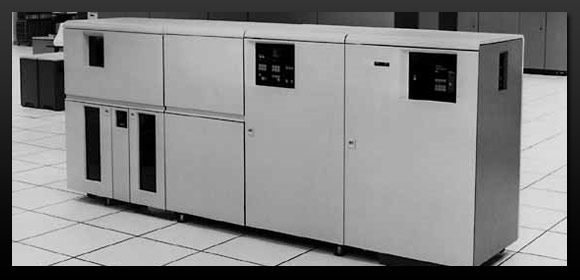
Above: The IBM 3800, the first commercial laser printer.
The first web server
And since the Web is such an integral part of today’s computer experience, we couldn’t help but include another first: The first web server was a NeXT workstation that Tim Berners-Lee used when he invented the World Wide Web at CERN. The first web page was put online on August 6, 1991.
The computer had a note on it that said, “This machine is a server. DO NOT POWER IT DOWN!!” Understandable, considering that if you had shut it down in the early days you would have shut down the entire WWW. 

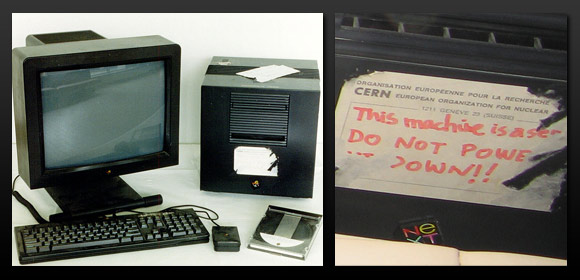
Above: The web server that powered the first web pages on the WWW. Note the sticker with the warning to not turn it off.
It’s amazing how much has happened in the PC industry in just a few decades. Just imagine what things will be like 30-40 years from now…
Tags
- -1st hard disk (1)-1st hard drive (1)-early laptop computers (1)-first hard disk invented (1)-first laptop computer (1)-grid compass (1)-historical development of computer (1)-pc memory history (1)-personal computer hardware (1)









0 comments:
Post a Comment